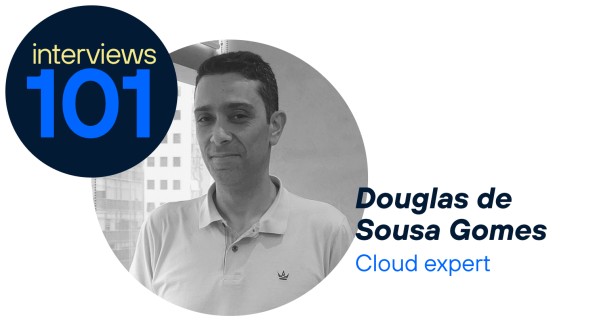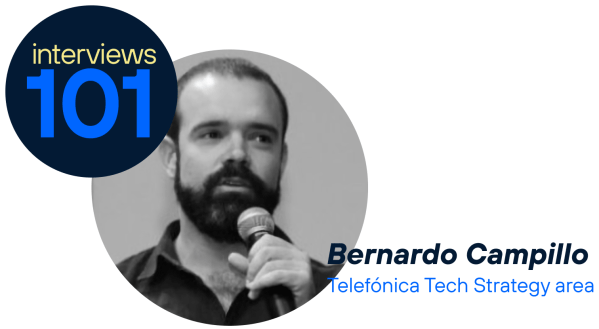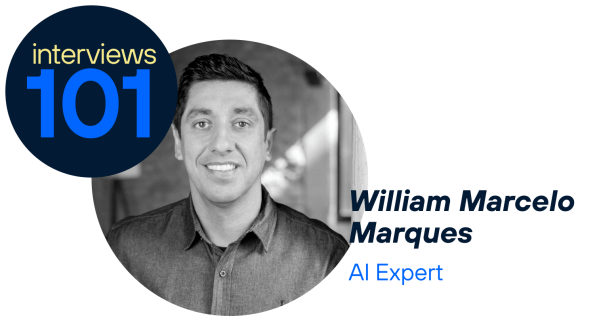Why 101?
To begin with, because from a scientific or technological perspective this number refers to the US university course coding system, where it is used to name the introductory beginner level course in a subject.
Likewise, this palindromic and prime number also refers to the 101 years of history that Telefónica celebrates in 2025, more than a century of life in which the company has evolved in step with society, positioning itself as a benchmark in the technological world, but not only in this type of issue.
Let’s look at some specific examples of interviews with different people from the company who, with heterogeneous professional profiles, do, however, have a common denominator: talent.
The Interviews 101 project serves to introduce us to Telefónica experts in a variety of subjects from whom we can learn and thanks to whom we can delve deeper into issues of a very different nature.
What are the limits of AI?
In this interview, our colleague Paulo Cocato, an expert in AI, explains the technical and ethical challenges of artificial intelligence. The fact that the data may be biased or insufficient can lead to unfair and inaccurate decisions, to which we should add the risk of reflecting prejudices and perpetuating biases.
‘The limit of artificial intelligence is its inability to understand complex contexts, show empathy or make decisions based on ethical values,’ summarises Cocato.
People: the driving force behind organisations
Derlin León, from the Culture, Training and Diversity team at Telefónica Hispam, values people as the driving force behind organisations.
With regard to the effective management of talent, León explains that ‘it undoubtedly requires a deep understanding of the uniqueness of each person within the organisation’.
He also emphasises the concepts of culture and training, ‘a key duo for the strategic and effective management of people’.
Benefits of 5G
Returning to technology-related issues, our colleague Patricia Robles, from Processes and Optimisation, analyses the advantages of 5G, how it differs from its predecessor – 4G – and how it interacts with other technologies such as AI or IoT.
‘5G not only improves connectivity, but also transforms the way networks are managed and personalised, opening up new possibilities for both users and businesses,’ says Robles, summarising the benefits of this technology.
What is network slicing?
A related technology to 5G is networkslicing; “the perfect ally”, in fact.
In the words of our colleague Beatriz Alba Toledo, from Business Services Development, ‘many experts compare this technology to an intelligent motorway, although all the lanes are built on the same infrastructure, each lane is reserved for a specific type of vehicle’.
A network slicing that facilitates the optimal use of the infrastructure by dividing the network into several independent parts ‘allowing resources to be allocated efficiently’.
The virtual shelf
Another of the most fashionable technologies of late is cloud storage, something that our colleague Beatriz Oliveira defines as ‘a virtual bookshelf accessible via the Internet’.
Although she recognises that it may seem a ‘fairly abstract’ idea since ‘the expression “it’s in the cloud” suggests something intangible’, as if what is in the cloud ‘floats above our heads’, Oliveira sums it up by saying that ‘however, behind this concept, there is a robust and carefully planned structure’.
Immersive and interactive experiences thanks to Virtual Reality
Virtual Reality or Extended Reality are technologies that, although they are already something palpable and tangible, have a wide horizon of improvement ahead of them. This is how Daniel Hernández, VP Devices & Consumer IoT at Telefónica, explains it, for whom ‘in the medium and long term, we can expect important developments in the field of XR devices’.
Likewise, Hernández believes that these new technologies ‘significantly’ reduce the digital divide ‘since there are more affordable devices’. He exemplifies this with the fact that ‘many educational institutions are committed to loan or financing programmes for XR devices to offer immersive educational experiences that benefit students in remote areas with limited resources’.
What is the customer journey
With our colleague Paula Martínez Roa, expert in User Experience and Innovation at Telefónica de España, we delve into what the customer journey is, a “tool for organising information in order to visualise in a simple and chronological way the experience that people have or will have with a certain product or service, focusing on the actions and emotions of that person in each phase.’
This is a particularly important issue for companies, both from the perspective of innovation and of improving products that have already been launched.
What is generative AI?
Our colleague Nelson Rodríguez is an expert in Artificial Intelligence and in this interview he delves into generative AI, a technology that he defines as ‘a branch of artificial intelligence designed to create new content: from text and audio to images and videos’.
This ‘powerful tool that has the potential to transform the way we work’ also has the particularity of being unique not only for its ability to create, ‘but also for its versatility to adapt to a wide variety of use cases in sectors such as health, education, marketing and more’.
Rodríguez explains that ‘its greatest strength lies in how it complements human knowledge’ allowing problems to be identified and solved more quickly, reducing operating costs or improving the consistency and quality of internal operations.












